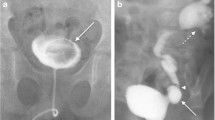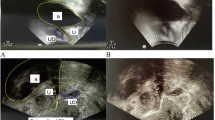Abstract
Background
Vaginal reflux is a functional voiding disorder seen in prepubertal girls without anatomical or neurological abnormality. When not associated with urinary tract infections (UTI), asymptomatic bacteriuria, post-void dribbling or daytime enuresis it may be considered a normal finding.
Objective
To review the radiographic features of vesicovaginal reflux based on multiple imaging modalities.
Materials and methods
Three girls aged 11, 13 and 5 years were referred for pelvic US for daytime incontinence, post-void dribbling, frequency and urgency. One girl also had recurrent UTIs treated with antibiotics and was investigated for vesicoureteric reflux with US and voiding cystourethrogram (VCUG). All three were examined with MRI.
Results
Imaging appearance common to all three girls was a fluid-filled mass posterior to the bladder that disappeared after voiding. A previous VCUG in one girl had shown contrast medium refluxing into the vagina which disappeared after bladder emptying. Pelvic MRI confirmed the findings in all three girls.
Conclusion
US examination of a distended bladder followed by a post-void study easily provides the correct diagnosis of vesicovaginal reflux by identifying the vagina as the fluid-filled mass. Treatment involves behavioural modifications. Though well known to urologists, this may be a perplexing pathology for the inexperienced trainee radiologist.



Similar content being viewed by others
References
Bauer S, Koff SA, Jayanthi VR (eds) (2002) Voiding dysfunction in children: neurogenic and non-neurogenic. WB Saunders, Philadelphia
Feldman A, Bauer SB (2006) Diagnosis and management of dysfunctional voiding. Curr Opin Pediatr 18:139–147
Capraro V, Greenberg H (1972) Adhesions of the labia minora. A study of 50 patients. Obstet Gynecol 39:65–69
Schaffer R, Taylor C, Haller JO et al (1983) Nonobstructive hydrocolpos: sonographic appearance and differential diagnosis. Radiology 149:273–278
Stannard M, Lebowitz RL (1978) Urography in the child who wets. AJR 130:959–962
Panaretto K, Craig J, Knight J et al (1999) Risk factors for recurrent urinary tract infection in preschool children. J Paediatr Child Health 35:454–459
Mattsson S, Gladh G (2003) Urethrovaginal reflux—a common cause of daytime incontinence in girls. Pediatrics 111:136–139
Sailer J (1979) Hematometra and hematocolpos: ultrasound findings. AJR 132:1010–1011
Snyder E, Nguyen RA, Young KJ et al (2007) Vesicovaginal reflux mimicking obstructive hydrocolpos. J Ultrasound Med 26:1781–1784
Franchi-Abella S, Waguet J, Aboun M et al (2000) Cyclic filling cystourethrography in the study of febrile urinary tract infection in children. J Radiol 81:1615–1618
Dacher J, Hitzel A, Avni FE et al (2005) Imaging strategies in pediatric urinary tract infection. Eur Radiol 15:1283–1288
Riccabona M, Avni FE, Blickman JG et al (2008) Imaging recommendations in paediatric uroradiology: minutes of the ESPR workgroup session on urinary tract infection, fetal hydronephrosis, urinary tract ultrasonography and voiding cystourethrography, Barcelona, Spain, June 2007. Pediatr Radiol 38:138–145
Davis L, Chunley WF (1966) The frequency of vaginal reflux during micturition—its possible importance to the interpretation of urine cultures. Pediatrics 38:293–294
Kelalis P, Burke EC, Stickler GB et al (1973) Urinary vaginal reflux in children. Pediatrics 51:941–942
Linshaw M (1999) Controversies in childhood urinary tract infections. World J Urol 17:383–395
Author information
Authors and Affiliations
Corresponding author
Rights and permissions
About this article
Cite this article
Kilicoglu, G., Aslan, A.R., Oztürk, M. et al. Vesicovaginal reflux: recognition and diagnosis using ultrasound. Pediatr Radiol 40, 114–117 (2010). https://doi.org/10.1007/s00247-009-1387-2
Received:
Revised:
Accepted:
Published:
Issue Date:
DOI: https://doi.org/10.1007/s00247-009-1387-2




